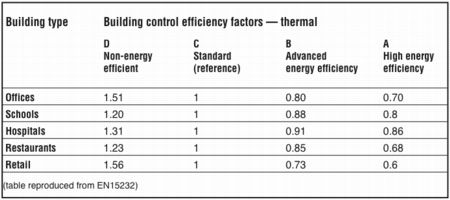The business case for controls

In today's business environment it is more important than ever to justify every investment, even when the ultimate goal is carbon reduction. Ian Ellis offers some insight into a European standard that can help to show the value of building controls.
It would be no surprise to find that sustainability issues have been pushed down the business agenda in this tough economic climate. However, it is important to bear in mind that often, for relatively low costs, building-controls technology offers a rapid return on investment that will impact positively on the bottom line.
Carbon Trust figures that are widely quoted state that a well-controlled commercial building can be over 30% more efficient than one with no controls, or where they are not used correctly.
One of the main reasons that building controls can have such a dramatic effect on energy use in buildings is that they impact directly on many areas of building services: ventilation; cooling; lighting; hot water and heating. In fact, building controls cover around 80% of energy used in most commercial buildings.
The Building Controls Industry Association (BCIA) is keen to highlight the important fact that the correct use of controls is vital to achieve the level of potential savings that have been identified. In fact, our key message is to use what you have before considering further investment. Reviewing your current control strategies and simple steps such as checking on sensors can ensure that building controls are doing what they are supposed to do. A surprising number of controls can be left in ‘manual override’ mode, leaving systems permanently ‘on’ and wasting large amounts of energy, and money.
However, it can often be important to consider adding to or upgrading existing controls systems, especially in older buildings. One of the most useful documents for anyone considering such a step is EN 15232 (‘Energy performance of buildings. Impact of building automation, controls and building management’), which has also been adopted as a British Standard.
This standard is one of a set of standards designed to support the European Energy Performance of Buildings Directive. The standard is not currently mandatory, but is certainly helpful for identifying the benefits of investing in various types of building control as well as the potential energy savings in a range of buildings.

EN 15232 defines the minimum levels of building controls required to achieve different levels of energy efficiency in a number of building types.
The standard was developed using advanced building simulation modelling, so it can be used as a tool to quantify the energy efficiency of building control and building energy management systems (BEMS) projects. This means that it is also possible to quantify the benefits of different levels of building control — putting specification and calculation of payback periods on a firm footing. Further, when considering the wide range of controls technologies now available on the market, using the EN15232 calculations can help to make that choice in a well-researched and unbiased way.
For specifiers, EN 15232 assigns classes A, B, C or D to levels of control within a building, and shows the resulting energy efficiencies that could be expected. This is an invaluable tool for those looking to balance capital investment against long-term energy savings. It also makes specification of BEMS a much clearer process for everyone involved, from the end-user client to the installer.
For example, it is possible to use EN 15232 calculations to determine the impact of building-control functions on the energy efficiency of a building by comparing two energy-demand calculations using different functions. In this way, specifiers can calculate the different potential costs and set these against the potential energy savings in the short and long term. The table on the previous page is taken from the standard, and shows the potential impact of controls on the thermal efficiency of non-residential buildings:
The BCIA is recommending use of EN 15232 for specifiers and end-users who are planning a building controls or BEMS project. Not only does the standard give a clear indication of energy savings that can be expected from the use of controls, it also offers a common language for specification.








